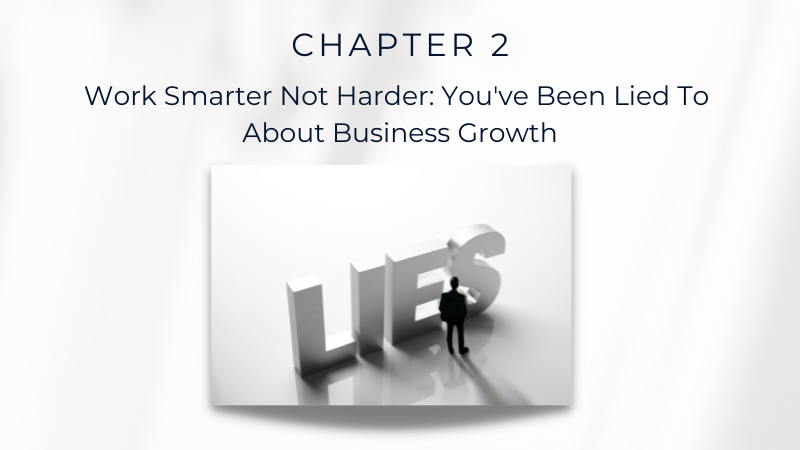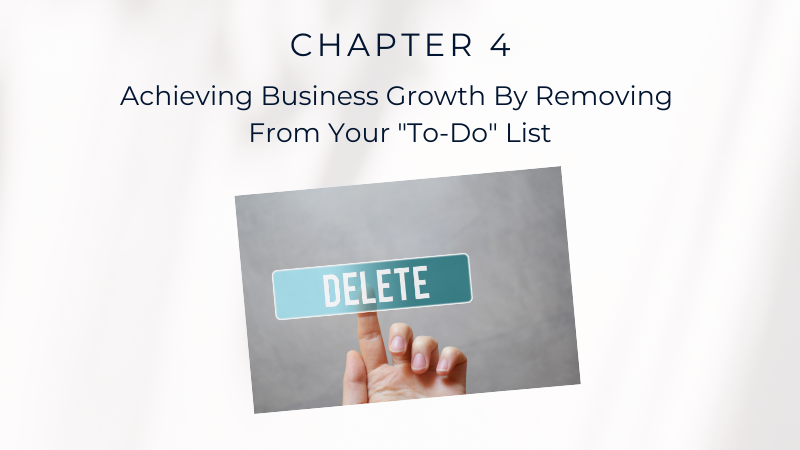This may be the most powerful growth hacking reference article you’ll ever read for growing your business and improving your life. We’ve purposely filled this with the most powerful, yet concise principles that can transform your entire business when implemented correctly. If you take these 12 principles seriously and put them into practice, we believe they can transform your life too.
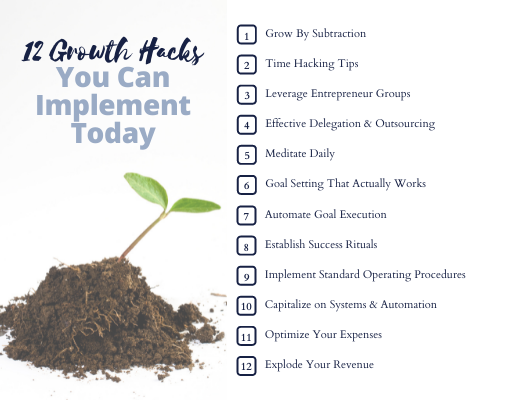
If you’re reading this, we assume that you are intrigued by the idea of learning how to grow your business even faster by taking MORE time off. And we are here to tell you that it is absolutely possible, and easier than you might think.
Let me assure you that the following strategies aren’t just a rehash of what you hear everywhere else. Let’s get started, shall we?
Growth Hack #1: Grow By Subtraction
We have been taught in the North American business culture that you have to hustle to be successful. But that’s simply not true. It is absolutely crazy to feel guilty about working less hours if you get the same results in 3 days as you used to do in 6. Yet we still do it. So how do we solve this problem of working harder, instead of smarter, when the odds are so deeply stacked against us?
A better way to approach your to-do list is to focus on doing fewer things and limiting those to activities that really matter. I call this “Growth by Subtraction.”
This means you have to become great at prioritizing and finishing the critical few projects that really matter, while ignoring or delegating everything else. You want every minute that you’re working in your business to really count.
This may sound counter intuitive, but it works! It’s about focusing on the critical few efforts that will produce the greatest results.

Grow by Subtraction is such a compelling resource and growth hack, that we have dedicated an entire chapter to this subject. You can learn more about how to implement these grow by subtraction principles in Chapter 4.
Growth Hack #2: Time Hacking Tips
A time hack is a strategy that is designed to help you get through your to-do list even faster. Examples of time hacks include delegating the task to another team member, batching similar tasks together, and finding a faster way to complete critical projects.

The bottom line is that if you start planning out your daily tasks using the incredibly effective process that we recommend, you will be amazed at the results.
Time hacking and the powerful process that you can use to implement it is covered in detail in Chapter 5.
Growth Hack #3: Leverage Entrepreneur Groups
Have you ever noticed that it can be pretty lonely at the top? This is probably the biggest downside to being an entrepreneur.
In this growth hack, we encourage business owners to seek out and join CEO/Entrepreneur Mastermind groups. The opportunity to spend time and network with other executives and entrepreneurs on a regular basis can (and will) be priceless.

Don’t re-invent the wheel if there are others who are willing share ideas and solutions.
In Chapter 6, I share how I have used mastermind groups over the past 15+ years to generate millions of dollars in revenue, as well as incredible friendships and memories that I cherish.
Growth Hack #4: Effective Delegation and Outsourcing
Delegation and outsourcing are some of the greatest hacks you can leverage in your business. But most business owners do this all wrong. Thankfully there is an easy way to fix this, which we cover in great detail in Chapter 7.
True freedom comes from owning a business, not from having a business that owns you. When you master the art of effective delegation and outsourcing, you will be one step closer to having true freedom. Part of this mastery includes having a 24/7 operation, which we also cover in more detail in Chapter 7.

Growth Hack #5: Meditate Daily
The next growth hack is to meditate daily, which may not seem like a growth hack, but it truly is.
Meditation will help you have a better quality of life. Many people think they are doing it wrong. They continue to have too much mind chatter, too many thoughts where their mind is always racing. I was one of those entrepreneurs who couldn’t seem to shut it down.
But a lot of my entrepreneurial friends told me that meditating regularly had helped them solve some of their biggest problems. I decided to sign up to attend a meditation retreat. Meditation has since transformed my life. It answered my life-long question:
“How can I have the schedule and freedom I’ve always wanted, without sacrificing my income?”
The answer I discovered during meditation has led me down this path of creating the freedom lifestyle I had always dreamed of. Now I’m in a position to share the insight you need on what it will take to create the lifestyle business you’ve always wanted too.
You will always have break through thoughts, but you learn to watch them flow by. Your brain will never stop but meditation allows you to slow it down. This opens the mind for new ideas and this is when the magic happens. When you can focus your attention on the silence, you stop the inner dialogue and your mind becomes clear. It is the space between the thoughts when we find solutions to problems.
It is recommended that you mediate daily and make it a consistent practice. A 10-minute habit can make all the difference in the space between acting and reacting. It changes your brain chemistry, it changes your outlook, and it changes your happiness. Imagine a snow globe. When you shake it up it is chaotic and cloudy, but after you set it down, after a few moments the turbidity settles and we have clarity.
This is the same process that happens when you meditate…you clear your brain from the scrambled activity and focus on the silence. If you are on the fence about meditation and you are a busy entrepreneur who thinks they don’t have time for it, I am here to tell you that the hardest part is just getting started. Even if you start with 5-10 minutes at a time, just do it and you’ll get the benefits of being happier, tapping into higher intelligence and creativity, and having more flow opportunities.
Once you get into it, I am sure it will quickly become your favorite part of the day. Meditation creates a sense of calm, improves your attention, and enhances your concentration. These are all necessary characteristics to being hyper-focused on achieving your daily, weekly and monthly goals.

And starting each day with a clear head is putting you on the path to emotional wellbeing and achieving balance between your work and creating the meaningful life you were meant to live.
Check out this podcast interview I did with Jason Campbell, co-founder of Zen Wellness, a musician and 7th degree blackbelt. Jason shares more about the importance of finding your “zen” and how to turn meditation into a daily habit.
005 Jason Campbell: Meditation Hacks by a Zen Master | The Vacation Effect
Growth Hack #6: Goal Setting that Actually Works
For the next growth hack, we will talk about goal setting that actually works. You are probably already good at creating both short and long term goals to reach a desired outcome. But are you being effective with how you map out your strategy to achieve your end results?
You need a way to plan out your bigger goals and break them down into the steps that will lead to real results. You may think you are already doing this, but most entrepreneurs are not doing so effectively.
Instead, you may find yourself spinning in circles, kind of like a hamster on a wheel; juggling a handful of projects and pivoting back and forth to get one task done here and another there? You will be surprised to hear that when you jump around way too much, your productivity actually decreases. Instead, focus on one or two areas and finish them, and then start focusing on the others.
An effective way to get started this way is to map out your goals at a high level, and then go deeper on each one by specifying what are some of the ways you can accomplish each of those goals.
Here’s an example of a Goal Setting Worksheet that can help you implement this methodology.
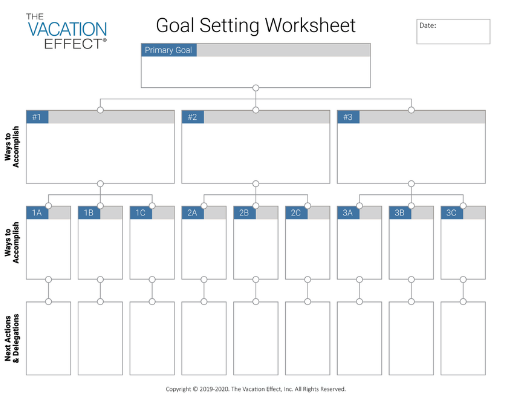
The key is to write down your primary goal first, and then 3 ways you could accomplish that goal (in spaces #1, #2, and #3). You can then drill down further and map out 3 ways to accomplish each of those objectives. Then, you list out the next actions and delegations for each.
Let’s look at a filled out example to further illustrate how this works.
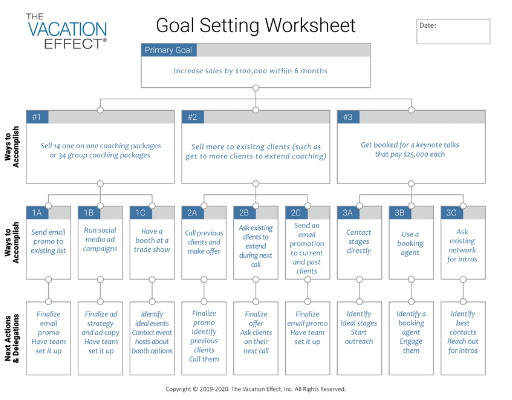
If you jumped around the chart and completed tasks under 1B, some under 2A, some under 3C, and maybe a few under 1A, do you think the results will add up? They won’t. You’d be jumping around too much, and it wouldn’t add up to success in any area as a result. If you want to have real success, it is important that you focus on completing everything under a particular branch/objective in the tree (such as 1A) if you want to have success with that branch/objective. This is the biggest mistake I used to make in missing my goals. If you put this method into practice, you can fix this problem once and for all.
Growth Hack #7: Automate Goal Execution
Once you have a goal setting process that works, it is important for you to automate the execution of those goals. That is the next growth hack.
It’s critically important for you to have a monthly, weekly, and daily ritual for how you prioritize your day, and how you ensure that you’re making progress on your goals in alignment with your team and working on the right things. This allows you to see what actions need to be taken to have success in a given category so your results continue to lead to the desired outcome.
The same is also true for your team. You should create quarterly goals with your team members and check with them weekly to track their results. Do a daily 5 minute check-in to be sure they are still on task. As part of your own weekly planning, jot down your action items for the week that will allow you to make progress in your own areas. And then actually DO those things you wrote down. They won’t magically get done on their own.
Now that you have shared your vision and assigned tasks to your team, what systems are in place to make sure you are meeting your goals? Goal Setting is an important part of designing your vision, but utilizing scorecards is one way you can measure your progress. Scorecards track key indicators for business.
You can choose a methodology that works best for you but developing a scorecard metric system will tell you if something is broken. For example, if you had been receiving 10 leads per week through your website, but for 4 weeks in a row, you only received 1 or 2 leads, wouldn’t you want to know why? Are you sure you would have noticed this if you didn’t have system in place showing you the true data? Goal setting is only successful when you are able to track your important Key Performance Indicators to tell you what’s happening automatically. When you are driving your car, don’t you rely on your dashboard to light up if there is a problem…consider business scorecards your dashboard.
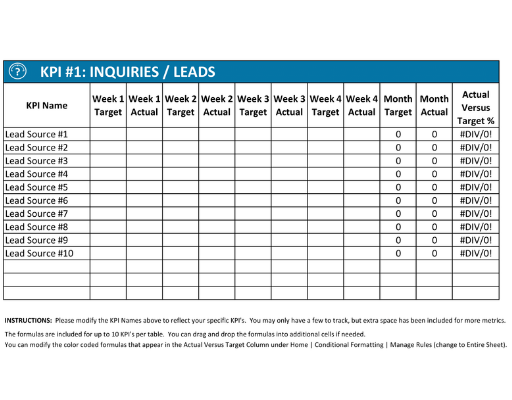
Utilizing scorecards are a time saver when you need to track your progress. Make it a weekly habit to have your leadership team update a scorecard ensuring constant forward momentum in your business. With today’s technology, a weekly team meeting with your “key” players to review progress on their goals plus the company scorecard is critical to growth. It will also move you one step closer to creating a freedom lifestyle and a company that doesn’t need your constant attention.
Growth Hack #8: Establish Success Rituals
In hack #8, we’ll look at how you can use success rituals to help you reach your goals automatically.
What is a success ritual?

A success ritual is when you tie your goals to a regular ritual, where you can succeed automatically, without needing a lot of willpower. For example, if your goal is to write a book, you might create a success ritual of writing 250 words per day.
That number is small enough that it is achievable. But if you do that consistently, you can look up in 4 months and have yourself a finished manuscript ready for final editing.
As another example, suppose your goal is to lose 1-2 pounds per month. You could develop a success ritual of 15-20 minutes per day of movement. “Movement” is generic enough that it can be done whether you are traveling or not, whether it is sunny or rainy, or whether it is hot or cold outside.
Look at your goals and see which ones you can make happen automatically if you just tied them to a daily or regular ritual.
The key in setting success rituals is to pick something that (1) you can easily do no matter what so it is “excuse-proof,” and (2) will add up over time to the desired result. We know this sounds incredibly simple, but this simple principle can change your life if you actually put it into action.
If you want to have the best results with success rituals, we recommend you have at least a morning success ritual after you wake up and a bedtime success ritual before you go to bed.
Some examples of morning success rituals might be exercise/movement, meditation, planning out your day, where some evening success rituals might be no technology before bed or making sure you get 7-8 hours of sleep per night.
Success rituals can be added anytime you want to have a consistent routine that adds up to real results. Success rituals can also be used for automating the achievement of your goals, like the weekly team meeting we discussed in the prior hack.
Establishing your own success rituals will ultimately add up to achieving your overall desired outcome before you know it.
Growth Hack #9: Implement Standard Operating Procedures
A great way to give yourself incredible freedom is to clone yourself and what you know so others can carry that out even when you aren’t working.
Of course, other team members will also have a lot of knowledge that should be captured too, so it is important to capture this information and put it down in writing. The vast knowledge that you and your team have are an incredibly valuable intellectual asset of the company.
The best way to capture this knowledge is through standard operating procedures that document the ways certain tasks are performed. That is the 9th hack we are going to cover now.
So many entrepreneurs do not have written policies and procedures. And others that do have some procedures in place still have a long way to go to grasp the benefit of this growth hack.
The best way to free yourself from the trenches of the business is to have detailed procedures for every aspect of the business so you and everyone else can be replaced.
Here is what I recommend to help you get standard operating procedures created for yourself:
Any time you find yourself training or explaining to your team, record it and ask that the team member to put it into a draft procedure.
Pick the most critical activities in the company that you and other team members do, and have those drafts created first.
Update the draft procedures each time that activity or task is being performed.
Consider blocking off 2-3 days with some of your key team members with the sole purpose of creating draft procedures for the company’s most critical operations.
In terms of the actual format of the policies and procedures, I recommend something like the following:
Create procedures for the following categories of your business (which are the same categories that a business in any industry can use):
A. Marketing / Client Attraction
B. Sales / Client Enrollment
C. Delivery of Client Work
D. Team
E. Office Environment
F. Money / Business Metrics
If you are saving these files on your hard drive or an online drive, consider using a naming scheme that starts with letters, so they sort alphabetically on your computer hard drive.
Also, consider using a naming format similar to the below to make it easier to insert new procedures over time.
A. Marketing – Client Attraction
A1 Keep in Touch Strategy
A1.1 Print & Email Newsletters
A1.2 Periodic Gifts or Articles Mailed to Clients
A1.3 Birthday Cards & Holiday Gifts to Clients
Include a header and change log at the top of each procedure document, to track details about who created it, the purpose of the procedure, when it was last updated, and by whom.
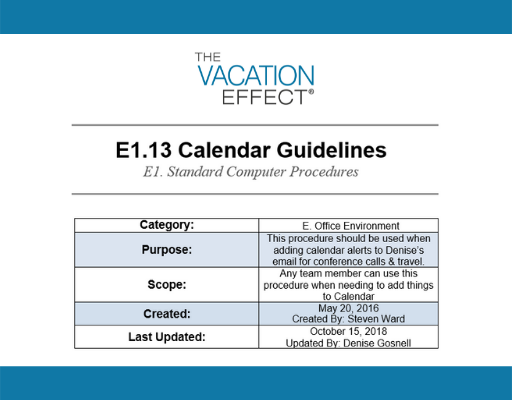
If you do those things, you will be way ahead of most of the other businesses out there. You can also use various types of online software platforms available today (such as Trainual) to store your procedures instead of having them on shared drives. But the important point here is to just get them done!
Policies and procedures = MORE FREEDOM. That is the hack.
Growth Hack #10: Capitalize on Systems & Automation
Once you have your key policies and procedures clearly documented, it becomes a lot easier to identify the areas that can be automated. Hack #10 is to fully capitalize on systems and automation.
There are 4 different types of automation: people automation, template automation, software automation, and hardware automation.
Let’s look at each one in more detail, including how you can best leverage them in your business and life.

1. With people automation, you can either make something a habit yourself so it gets done automatically or you can have a standard operating procedure that your team can follow.
2. With template automation, you have various templates in Word documents, Google documents, email signature footers, or other file formats where you just pull them up whenever needed to reuse them multiple times.
3. With software automation, you use software to complete some part of the task for you. I was a software developer for 10 years before I became a business strategist and lawyer, so I have a lot of experience using all kinds of software automation over the years, such as:
Document automation, where you convert a template into something that gets filled out automatically by software—using a tool like Formstack.com (formerly Webmerge.me)
Keyboard shortcuts, where you hit a certain keystroke to have a certain command carried out
Text expansion, where when you type a certain phrase, it automatically replaces the text with something else—like the 6-part delegation instruction template that appears when I type the word “delegate.”
Batch processing of the same type of task, where you convert a group of selected Word documents into PDF documents.
Another example of software automation is having systems that talk to each other to perform a series of actions. Tools like Zapier make it easy for hundreds of online programs to talk to one another.
4. With hardware automation, you use physical machines such as robots to perform certain tasks for you.
I wanted to call this out as a separate category from software automation, because robotics is currently an emerging area of technology.
One of these emerging areas is a renting robots service where you can rent someone else’s robots for a period of time. This is making it easier to have access to robot technology without having to buy the robots yourself.
I know this may not apply to your company just yet, but I at least wanted you to be aware that this type of technology is becoming increasingly popular, especially in fields like manufacturing.
The bottom line with automation is that you should always be looking for ways to automate and streamline your repetitive activities across all levels of the company. When you do you can reap significant rewards.
Growth Hack #11: Optimize Your Expenses
In the next hack, we will look at how to optimize your expenses, including some ways you may not have considered before.
This important strategy should be revisited at least a few times per year so you can really optimize your profitability and growth of your business over the long term.

Here are several ways you can reduce your expenses:
● Look for subscriptions you can cancel that aren’t needed or that can be consolidated with other subscriptions.
● Periodically re-negotiate contracts with vendors. We recommend you analyze your vendor contracts at least once per year. This is a great chance to revisit what is fair for what you need, and to make adjustments if your needs have changed.
● Negotiating discounts at retail stores. You can talk to store managers and often negotiate discounts on your purchases or have them include some other benefit.
● Another great strategy you can use to cut your expenses is to figure out how to turn existing expenses into profit centers. The way this works is that you can take a look at some of your biggest expenses, and ask yourself, “Is there any part of this I could convert into a profit center, like renting out some time of any under-utilized employees to my clients or friends?”
● Another way you can cut your expenses is to find ways to reduce your taxes, such as using some creative tax planning. Here are some examples:
o Rent your own home to your business for up to 14 days under the Augusta Rule (much like you would have rented hotel meeting space for your company.)
o Have a home office accountable plan
o Set up a pre-tax health insurance plan using pre-tax dollars to reduce your taxes owed
o Move to a state with lower state income or corporate income taxes
o Convert your entity type to a different entity type that has lower taxes
Now that we’ve covered several ways to optimize your expenses, let’s move on to the next growth hack for how to explode your revenue.
Growth Hack #12: Explode Your Revenue
If you want more profit, you have to always be aware of ways you can generate more cash flow. You need to always be focusing your efforts in the right areas.
In order to increase the revenue for your company, you can do two things.
1. You can increase the number of people who see your offers (increase traffic).
2. You can increase the number of people who accept your offers (increase your conversions).

If you want to see the most dramatic increase in company revenue, you should focus on increasing BOTH traffic and conversions.
Increasing Traffic
So, how do you increase your traffic? You can do so by advertising in more places, getting exposure through social media, getting more free traffic from the search engines, by using joint venture partners, and so on.
Increase Conversions
Even if you never increase the amount of traffic that you are getting to your offers, you CAN increase the revenue for your company by simply increasing your conversions. You can often double your profits by implementing a few conversion strategies covered below.
1. Upsells: Add upsales to your sales process. An upsale is an offer of a related product or service. The best way to increase the effectiveness of your upsells is to make the customer feel like you are giving them the opportunity to customize their order.
Let’s say you have a website. You can make use of lead capture pages (opt-in pages) to offer the customer something valuable in exchange for their name and email address. Then, on the thank-you page, you make them an offer to buy one of your products that is related to the free item that they just opted-in to receive. Now that you have their email address or other contact info, you can follow-up with them over time and turn them into a customer, even if they don’t buy from that initial purchase.
2. Mail Discounts: You can mail discount coupons or other offers to your customers as part of their original order shipment, or at a later date.
3. Refer a Friend: Another effective strategy is to ask existing clients for referrals, and to make it easy for them. You can also consider rewarding customers for their referrals, such as a free gift when they’ve referred several new clients.
4. Reactivate Dead Customers: This is one of the most overlooked strategies. You can reactivate past customers by sending them a special promotion that gets their attention. Such as “We Miss You!” along with a discount coupon.
5. Put Offer for Related Items at Bottom of Each Receipt: This is an easy strategy that is often overlooked. Most customers will review their receipt carefully. So while you have their undivided attention, why not go ahead and offer them something else.
6. Make Your Offer Irresistible: You want to make what you are offering so appealing that people feel compelled to buy it because they can’t live without it or it’s such a great value, they can’t pass it up. You can also add a strong guarantee, such as a 30-day or 60-day money back guarantee. The longer the guarantee, the fewer returns you will have, and the more comfortable people will be in making the purchase.
7. Reduce the Costs to Deliver Your Products or Services: If you take time to analyze your costs periodically, you can usually find several way to reduce the overall cost to produce the item in a way that will not decrease the number of sales at all.
8. Raise Prices: You can always raise your prices so there is a higher profit per sale. I’ve found that many businesses wait too long to raise their prices—when the demand is high enough that customers would easily pay more.
9. Reduce the Number of Returns: One idea is to offer the customer an alternate produce or service instead of giving them a refund. Another great strategy to reduce your refund rate is to send unexpected gifts to the customer. You should also consider sending the customer a “Thank You” card separately from their initial order.
10. Add New Revenue Streams: Another often overlooked way to increase revenue is turning one-time revenue into recurring revenue by converting the product or service into a subscription.

The key take-away from growth hacks 11 and 12 is to always be mindful of optimizing your revenue and your expenses. By doing so, it will further support you and your goal of having plenty of freedom while your business continues to be profitable.
When you implement all 12 of these growth hacking strategies, you can create the freedom and business growth that you’ve always wanted, without having to pick one over the other.
Now, let’s dive into more detail on hacks 1-4 in Chapters 4-7 so you can super-charge your results.
In Chapter 1, you will explore the true meaning of business freedom and how to create it in your own life for what really matters.
In Chapter 2, you will learn the principle of work smarter not harder. You have been lied to about business growth in the past and will be shocked once you discover the truth.
In Chapter 3, you will discover 12 different growth hacks that lifestyle entrepreneurs use daily. You can use these growth hacks yourself for faster growth and a better life.
In Chapter 4, your will learn how to achieve business growth by removing from your “to-do” list, not adding to it. This principle is called “Growth by Subtraction”, and when done correctly, it leads to “multiplication”.
In Chapter 5, you will discover several ways to use time hacking to double your productivity. Are you ready to “Get Shit Done” faster than you ever imagined?
In Chapter 6, you will unlock the closely held secrets to leveraging entrepreneur groups for fast business growth. This strategy can skyrocket your growth.
In Chapter 7, you will learn all about delegating tasks effectively. Hint: Most business owners do this totally wrong.
In Chapter 8, discover how you can create a 4 day work week for yourself that is sustainable long term. It’s easier to accomplish than you might think.
In Chapter 9, you’ll learn the recommended next steps for creating the freedom lifestyle that you deserve. You’ll also learn the best resources (including a business growth coach) to support you in this process.







